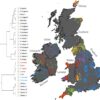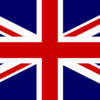【アイルランド】日本の反対端に当たる島国:DNA解析でわかる複雑な形成過程
ブレクジット問題にアイルランドが揺れている。20年前、ノーベル平和賞受賞者まで出した歴史的なベルファスト合意(Good Friday Agreement)。しかしブレクジットが寝た子を起こし、アイルランド版宗教戦争(カトリックとプロテスタントのガチバトル)を再燃させかねない。日韓のねじれた歴史に似て、一筋縄でいかない英愛関係。今回はアイルランドという国に注目してみよう。
イギリスの巻き添えになるアイルランド
ベルファスト合意とは、コトバンクの解説を抜粋すれば、次の通り。
交渉の最新情勢
ブレクジット交渉の最新情勢については以下のBBCニュースを参考にしてほしい。
How Brexit could create a crisis at the Irish border
ベルファスト合意に至るまでの歴史背景については、以下の7分程度の英語動画に手際よくまとめられている(英語字幕付きなのでヒアリングの勉強にもなる)。
遺伝子調査からわかるアイルランド人の出自
今回の中心は、DNA解析によるアイルランド人の形成である。
アイルランド入植者の流入経路(出典: National Geographic)最初に、簡単にポイントを整理しておくと次のようになる。
- 総論:DNA解析の結果、アイルランド人=ケルト系という通説は「部分的正解に過ぎない」とのコンセンサスが形成されつつある。アイルランド人の組成はもっと多様である。
- 先史時代のアイルランドには幾波かの流入者があった。
- ひとつはスペインやサルデーニャ島の南欧からの移住者(この人々の遠祖は中東起源とされる)。
- もうひとつは、通説のように、ウクライナ北部のステップから中欧へ移動し、その後アイルランドへ入植した人々。現代アイルランド人の主流派(スコットランド人やウェールズ人に近い、イングランドもかつては似ていたが、アングロ・サクソンやノルマンの侵略で混血が進んだ)。
- アイルランド最古の『アイルランド来寇の書』の記述を裏付けるように、アイルランド人にはスペイン北部バスク地方の人々と似たDNA組成が見られる。
- 共通の先祖を持つオニール一族の血統が長く支配層を形成した。
- フランスのブルターニュ地方や西ノルウェーからも入植者があった。とくに北欧ヴァイキングの血は従来考えられていたよりも濃いと考えられている。
- アイルランド島とブリテン島(スコットランド+イングランド+ウェールズ)のDNA組成は近縁性が高い(⇒色白の肌、赤毛、そばかすなどの特徴)が、イングランドは他地域より混血が進んだ。
- 黒髪のアイルランド人を外国が「ブラック・アイリッシュ」と呼ぶことがあるが、この人々の先祖は北アフリカ、スペイン、アイルランドの間を行き来した交易商人もしくはスペイン無敵艦隊の人間ではないかといわれている。
- 政治思想犯としてカリブ海へ流されたアイルランド人と現地の黒人との混血で生まれた「ブラック・アイリッシュ」がカリブ諸島に居住している。

それでは、参照記事の英日対訳を始めよう。
Blood of the Irish(アイルランド人の血)
The blood in Irish veins is Celtic, right? Well, not exactly. Although the history that used to be taught at school said the Irish were a Celtic people who had migrated from central Europe, the latest studies of Irish DNA tell us a very different story.
アイルランド人にはケルトの血が流れている、という常識が疑わしくなっている。中欧にいたケルト民族がアイルランドに移住してきた―、これまで学校の歴史授業ではそう教わってきたが、最近のDNA研究はまったく違うストーリーを描く。
Research done into the DNA of the Irish has shown that our old understanding of where the population of Ireland originated may have been misguided. The modern Irish population share many genetic similarities with Scottish and Welsh populations, and to a lesser extent the English.
At the same time, DNA testing of remains of ancient Irish people suggests that some of the earliest human arrivals on the island originally came from much further afield. This article is based on the research available in early 2018 – however new discoveries are being published regularly so if you want to keep up-to-date on this topic make sure you check online scientific journals such as Nature.
近年のDNA調査によると、アイルランド人中欧起源説は誤解を招く表現ということになる。たしかに現代のアイルランド人は遺伝学的にスコットランド人やウェールズ人によく似ている。それより近縁性は低いもののイングランド人にも似ている。
しかし、先史時代の遺骸のDNAを調べると、最初期のアイルランド移住者ははるか彼方からやってきた可能性が高いのである。本稿は2018年はじめ時点の最新研究データに基づく。最新の情報については、定期的に最新の知見を公開している『ネイチャー』など科学誌のウェブサイトを参照してほしい。
Early Origins of Irish DNA(アイルランドDNAの起源)
The earliest settlers came to Ireland during the Stone Age, around 10,000 years ago. There are still remnants of their presence scattered across the island. Mountsandel in Coleraine in the North of Ireland is the oldest known site of settlement in Ireland—remains of woven huts, stone tools and food such as berries and hazelnuts were discovered at the site in 1972.
最古の入植者がアイルランドにやってきたのは石器時代の約1万年前だといわれる。痕跡は島のあちこちにいまも残る。たとえば、北アイルランドのコールレーン郊外には、アイルランド最古の入植定住地として知られるマウントサンデルがある。1972年、ここで織物の小屋、石器、果実やヘーゼルナッツなどの食糧の遺物が見つかった。
Where Did the Early Irish Come From?
(最初期の定住者はどこから来たのか?)
For a long time the myth of Irish history has been that the Irish are Celts. Many people still refer to Irish, Scottish, and Welsh as Celtic culture. The assumption has been that they were Celts who migrated from central Europe around 500BCE.
アイルランド人はケルト人である―、これが長い間信じられてきたアイルランド史の神話だ。いまでも多くの人々がアイルランド、スコットランド、ウェールズをケルト文化と呼ぶ。BC500年前後に、中欧にいたケルト人がアイルランド島へ流入し住み着いた、という仮説を受け入れているためだ。
Keltoi was the name given by the Ancient Greeks to a ‘barbaric’ (in their eyes) people who lived to the north of them in central Europe. While early Irish art shows some similarities of style to central European art of the Keltoi, historians have also recognized many significant differences between the two cultures.
ケルトの語源はギリシャ語の “keltoi”、「野蛮人」の意味だ。ギリシャ北方の中欧に住んでいた人々は、古代ギリシア人の眼には野蛮に見えたのだろう。アイルランド初期の芸術はケルトイ人の芸術と似た様式を持つ場合もあるが、専門家によると両者は違いの方が大きいという。
Recent research into Irish DNA at the beginning of the twenty-first century suggests that the early inhabitants of Ireland were not directly descended from the Keltoi of central Europe. Genome sequencing performed on remains of early settlers in Ireland by researchers at Trinity University in Dublin and Queens University has revealed at least two waves of migration to the island in past millennia.
Analysis of the remains of a 5,200 year-old Irish farmer suggested that the population of Ireland at that time was closely genetically related to the modern-day populations of southern Europe, especially Spain and Sardinia. Her ancestors, however, originally migrated from the Middle East, the cradle of agriculture.
21世紀はじめダブリン大学とクイーンズ大学がアイルランド人DNAの共同調査を行った。その結果何がわかったかといえば、アイルランドの初期定住者が、中欧のケルトイ人から直接派生したのではないこと、そして遺骸のゲノム・シーケンシングの結果、過去数千年間に最低2回の移動波があったことである。
5200年前の農民(女性)のゲノムを解析すると、当時のアイルランド人口は、遺伝子的に、現代の南欧、とくにスペインとサルデーニャ島の住民と近縁性が高いことがわかった。彼女の祖先をさらに辿ると農業の発祥地中東に至る。
Meanwhile, the research team also examined the remains of three 4,000 year-old men from the Bronze Age and revealed that another wave of migration to Ireland had taken place, this time from the edges of Eastern Europe. One third of their ancestry came from the Steppe region of Russia and Ukraine, so their ancestors must have gradually spread west across Europe. These remains, found on Rathlin Island also shared a close genetic affinity with the Scottish, Welsh, and modern Irish, unlike the earlier farmer. This suggests that many people living in Ireland today have genetic links to people who were living on the island at least 4,000 years ago.
さらに青銅器時代、いまから4000年前頃の男性3人の遺骸を解析した結果、東欧沿岸からの移民だったことがわかった。この東欧人の祖先は、その3分の1がロシアとウクライナにまたがる草原地帯から徐々に西へ移動して来たと考えられている。これらラスリン島(※北アイルランド)で発見された3人の遺骸は、さきほどの農民女性とは違い、スコットランド人、ウェールズ人、現代アイルランド人と近縁性が高い。つまり現代のアイルランド人の多くは、4000年前のラスリン島住人と遺伝的につながりが濃いのである。
Do Irish Origin Myths Match the Scientific Evidence?(アイルランドの創世神話は科学的証拠と一致するか?)
One of the oldest texts composed in Ireland is the Leabhar Gabhla, the Book of Invasions. It tells a semi-mythical history of the waves of people who settled in Ireland in earliest times. It says the first settlers to arrive in Ireland were a small dark people called the Fir Bolg, followed by a magical super-race called the Tuatha de Danaan (the people of the goddess Dana).
アイルランド最古の文献のひとつに『アイルランド来寇の書』(Leabhar Gabhla)がある。数波に分かれて太古のアイルランドに定着した人々に関する神話的な歴史の伝承である。同書によれば、アイルランドには、トゥアサ・デー・ダナン(ダーナ女神族)と呼ばれる神人がやってくる前、すでに肌が黒く背の低いフィル・ヴォルグと呼ばれる人々が住んでいた。
Most interestingly, the book says that the group which then came to Ireland and fully established itself as rulers of the island were the Milesians—the sons of Mil, a soldier from Spain. Modern DNA research into male Y chromosomes has found that the the R1b haplogroup reaches very high concentrations in Western Ireland and the Basque country in northern Spain. While the picture for matrilineal descent (mother to daughter) is more complex, it seems that the northern Spanish and the Irish might have common male ancestors at some point in history.
同書の最も興味深い記述は、最後にアイルランドに来て島全体を征服したのをミル族 ―スペインから流れ着いた兵士ミル(Míl Espáine)の息子たち― だったとしている点だろう。この記述を裏付けるように、近年の男性Y染色体調査において、西アイルランドとスペイン北部のバスク地方にR1bハプログループが非常に高濃度で発見されている。母から娘へ伝わる母系遺伝は特定が難しいのの、スペイン北部とアイルランドは歴史のどこかの時点で共通の男性祖先を持つと考えてよさそうだ。
There are also interesting cultural similarities along the western seaboard of Europe, stretching from Spain up to Ireland – as has been written about by the archeologist Barry Cunliffe. Although it might seem surprising, it is worth remembering that in ancient times the sea was one of the fastest and easiest ways to travel. When the land was covered in thick forest, coastal settlements were common and people travelled around the seaboard of Europe quite freely.
考古学者バリー・カンリフの著述によると、スペインからアイルランドに至るヨーロッパ西海岸には、興味深い文化的な類似点が見い出される。意外に思われるかもしれないが、古代には海路が最も速く容易な移動手段だったのひとつだった。陸地が深い森林に覆われていた当時、人は海辺に居住するのがふつうで、苦もなく海伝いを移動していたのだ。
Another interesting finding about Irish DNA is that many men in North West Ireland (and their descendants around the world, including about 2% of men in New York today) are descended from a single man who lived in Ireland around 1600-1700 years ago. This coincides with the time of the famous Irish king Niall of the Nine Hostages, who legend says brought St Patrick to Ireland as a slave. The O’Neill family, who claim to descend from Niall, have certainly been a powerful family through the ages in Ireland.
アイルランドDNAに関しては、もう一点興味深い知見がある。北西アイルランドの多くの男性(および現代ニューヨークに住む男性の約2%)は、1600~1700年前にアイルランドを支配していた同じ一人の男性の子孫なのだ。これは有名なアイルランド王ニール(「9人の人質も持つニール」のあだ名がある)の時代と一致している。伝説では、ニールが聖パトリックを奴隷で連れてアイルランドに来たとされる。実際、ニールの末裔を自称するオニール一族は長くアイルランドで威を誇った。
Meanwhile, the latest research in 2018 suggests that the Irish are most closely related to people in North West France (Brittany where a Celtic language has traditionally been spoken) and in Western Norway. Interestingly, where earlier studies didn’t find much impact of Viking DNA among the modern Irish, a recent study suggests there may have been more influence than perviously thought. You can read more details here: https://www.nature.com/articles/s41598-017-17124-4
2018年に行われた最新のDNA調査によると、アイルランド人は遺伝学的に北西フランス(伝統的にケルト語が話されているブルターニュ地方)と西ノルウェーと近縁性が高い。従来の研究では現代アイルランド人に北欧ヴァイキングの血は薄いとされていたが、近年の研究では、考えられてきたよりヴァイキングの影響が濃い可能性が示唆されている。この点の詳細については、以下をご覧いただきたい。
What we can take from all of this is that, although the Irish today feel part of a single group united by cultural and national identity, this culture and identity is ultimately founded on waves of migration connecting the island to the wider world of European peoples and beyond.(中略)
以上をまとめれば、現代のアイルランド人は共通の文化と国民性でつながれた単一集団への帰属感を感じているものの、実際には、欧州内外から何波かに渡って渡ってきた移住者の複合として形成された、ということになる。(中略)
Irish and British DNA: A Comparison
(アイルランド島とブリテン島のDNA比較)
I live in Northern Ireland and in this small country the differences between the Irish and the British can still seem very important. Blood has been spilt over the question of national identity.
筆者は北アイルランドに住んでいるが、この小さな国ではアイルランド島とブリテン島の違いがいまもとても重要な違いと思われている。国家のアイデンティティに関する様々な面で血がものをいう。
However, research into both British and Irish DNA suggests that people on the two islands have much genetically in common. Males in both islands have a strong predominance of the Haplogroup 1 gene, meaning that most of us in the British Isles are descended from the same stone age settlers.
しかし、両国のDNA比較研究によれば、2つの島の住民は多くの遺伝的要素を共通している。どちらの島の男性もハプログループ1の遺伝子が非常に支配的で、ブリテン諸島の多くの人間は石器時代の定住者の子孫なのである。
The main difference is the degree to which later migrations of people to the islands affected the population’s DNA. Parts of Ireland (most notably the western seaboard) have been almost untouched by outside genetic influence since early times. Men there with traditional Irish surnames have the highest incidence of the Haplogroup 1 gene – over 99%.
両島が異なるのは、歴史時代の入植が与えたDNAへの影響具合だ。西海岸でとくに顕著なのだが、アイルランド人は入植初期の時代から外部の遺伝的影響をほとんど受けていない。伝統的なアイルランド姓を名乗る男性はハプログループ1遺伝子の発現率が99%を超える高率を示す。
At the same time London, for example, has been a mutli-ethnic city for hundreds of years. Furthermore, England has seen more arrivals of new people from Europe – Anglo-Saxons and Normans – than Ireland. Therefore while the earliest English ancestors were very similar in DNA and culture to the tribes of Ireland, later arrivals to England have created more diversity between the two groups.
しかし、たとえば、ロンドンは数百年にわたって多民族都市であった。さらにアングロ・サクソンやノルマンなど、イングランドにはアイルランドより頻繁に大陸から侵入者が入った。したがって最初期のイングランド部族は、DNA的にも文化的にもアイルランド部族と非常に近かったが、入植者の影響で差異が生じたと考えられる。
Irish and Scottish people share very similar DNA. The obvious similarities of culture, pale skin, tendency to red hair have historically been prescribed to the two people’s sharing a common Celtic ancestry. Actually, in my opinion, it seems much more likely that the similarity results from the movement of people from the north of Ireland into Scotland in the centuries 400 – 800 AD. At this time the kingdom of Dalriada, based near Ballymoney in County Antrim extended far into Scotland. The Irish invaders brought Gaelic language and culture, and they also brought their genes.
アイルランドとスコットランドはいまもDNA的な近縁性が高い。文化、白い肌、赤毛の発現など両者の明らかな類似点は、歴史的に共通のケルト系祖先によると考えられてきた。個人的には、この類似性はAD400~800年頃にアイルランド北部からスコットランドへ入植が続いた影響だと考える。この時代、北アイルランドアントリム州バリーマネーを本拠としたダルリアダ王国がスコットランドを侵略し、ゲール語とゲール文化をもたらすと同時に子孫を残したのではないか。
Irish Characteristics and DNA
(アイルランド人の特徴とDNA)
The MC1R gene has been identified by researchers as the gene responsible for red hair as well as the accompanying fair skin and tendency towards freckles. According to genetic research, genes for red hair first appeared in human beings about 40,000 to 50,000 years ago.
MC1R遺伝子は、赤毛と色白の肌、そばかすに関係する遺伝子だ。遺伝子研究によれば、この赤毛遺伝子は約4万〜5万年前に初めてヒトに現れたという。
These genes were then brought to the British Isles by the original settlers, men and women who would have been relatively tall, with little body fat, athletic, fair-skinned and who would have had red hair. So red-heads may well be descended from the earliest ancestors of the Irish and British.
そうであれば、この赤毛遺伝子は最初期のブリテン諸島への入植者によって持ち込まれたのだろう。最初期入植者は男女とも比較的背が高く、体脂肪の少ない痩せ型だった。また運動神経がよく、色白の肌をしており、赤毛を持っていたといわれる。つまり、現代人の赤毛は、この最初期のアイルランド島・ブリテン島入植者の遺伝的形質を受け継ぐものだろう。
Who Are the “Black Irish”?
(「ブラック・アイリッシュ」とは誰か?)
The origin of the term “Black Irish” and the people it describes are debated. The phrase is ambiguous and is mainly used outside of Ireland to describe dark-haired people of Irish origin.
「ブラック・アイリッシュ」という用語の起源と、その意味については多くの議論がある。このことばの意味は曖昧だが、通常はアイルランド以外の国で、黒髪のアイルランド人を指す。
The ambiguity comes in when trying to determine whether dark-haired Irish people are genetically distinct from Irish with lighter coloring. Dark hair is common in Ireland, while dark complexions are more rare.
黒髪のアイルランド人と、そうでない髪のアイルランド人を遺伝学的に区別できるかどうかとなると微妙だ。黒髪はアイルランド人に一般的だが、浅黒い肌は稀である。
One theory about the origins of the term is that it describes Irish people who descend from survivors of the Spanish Armada. There are other hypotheses, mostly placing Irish ancestors on the Iberian peninsula or among the traders that sailed back and forth between Spain, North Africa, and Ireland, particularly around the Connemara region.
一説によると、この言い方は、はじめスペイン無敵艦隊の生存者の末裔であるアイルランド人のことを指していたという。別の説では、アイルランド人の祖先は主にイベリア半島から来たか、あるいはスペイン、北アフリカ、アイルランド(とくにコネマラ地域周辺)を行き来していた交易者に由来するといわれる。
Some “Black Irish” are of Irish-African descent, tracing their ancestry back to the slave trade. Many of these people live on Barbados and Montserrat.
「ブラック・アイリッシュ」がアイルランド系アフリカ人を指す場合もある。彼らは奴隷貿易時代に南米へ流されたアイルランド人(※政治思想犯)と現地人の混血で、主にカリブ海のバルバドス島とモントセラト島に暮らしている。
<引用記事終わり>
最初期アイルランド入植者の外見想像図(出典: https://www.irishcentral.com/news/cheddar-man-dark-skin-first-irish)関連記事
アイルランドとは切っても切り離せないイギリス(あるいはUK)の地理的概略については以下の記事を参照してほしい。












ディスカッション
コメント一覧
まだ、コメントがありません